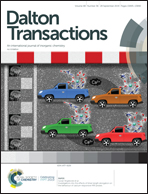Post-imparting Brønsted acidity into an amino-functionalized MOF as a bifunctional luminescent turn-ON sensor for the detection of aluminum ions and lysine†
Abstract
A novel aldehyde- and amino-functionalized luminescent metal–organic framework, Cd–TCHO, was constructed through the solvothermal reaction of 4,4′,4′′-tricarboxytriphenylamine, 2-amino-3-pyridinecarboxaldehyde and cadmium nitrate and was characterized. Post-synthetically oxidizing the aldehyde groups into carboxylate groups afforded a new complex, Cd–TCOOH, and this successful conversion process was confirmed by FT-IR and 1H NMR studies. With the Brønsted acidic sites inside the cavities of Cd–TCOOH, it could be used as a luminescent sensor for Al3+ detection with a high selectivity and sensitivity (LOD = 0.54 ppb), which could be attributed to the coordination between free Brønsted acidic sites and Al3+. Importantly, it could also detect Lys among 20 kinds of natural amino acids; the selectivity, sensitivity and the sensing mechanism are discussed in detail. Also, both of the sensing processes were carried out in the HEPES buffer.



 Please wait while we load your content...
Please wait while we load your content...